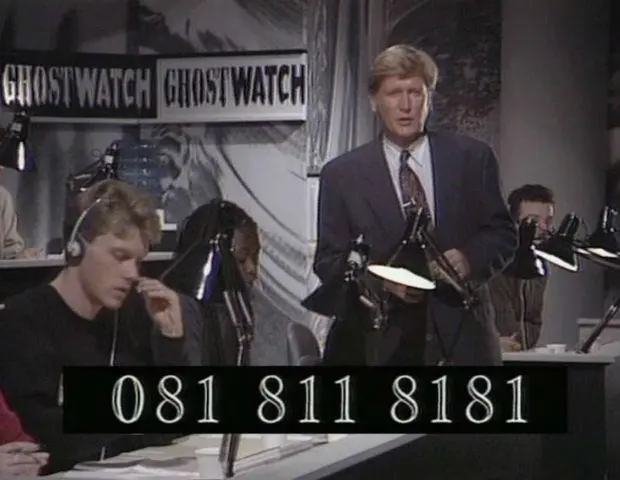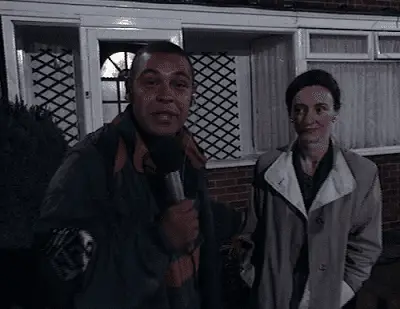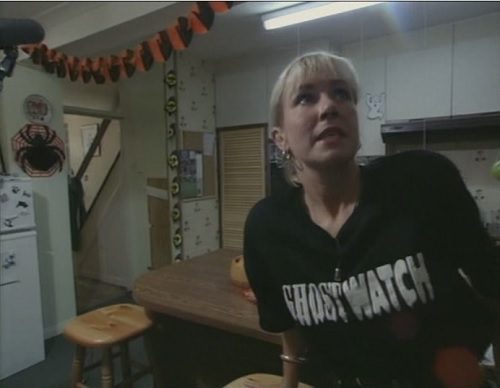The BBC has a long and storied tradition of scaring the crap out of kids, usually at Christmas time. But in 1992, the BBC decided to switch things up and traumatize the wee ones on Halloween for once. The result was a mockumentary pre-recorded “live” broadcast that birthed the found footage genre and threw the whole country into such a tizzy they never aired the program again.
Five years before The Blair Witch Project, Lesley Manning’s Ghostwatch shows the “real-life” investigation of the most haunted house in the UK in the fictional Foxhill Drive, inspired by the “real” haunting of the Enfield house. Ghostwatch went the extra step in cementing the verisimilitude of the mockumentary by getting real BBC personalities to play themselves.

National treasure Michael Parkinson held down the fort at the BBC studios, hosting the show and providing a calm, reassuring demeanor that everything was under control. Sarah Greene, a television presenter known for hosting kid shows such as “Blue Peter,” was on location at Foxhill Drive along with actor Craig Charles from “Red Dwarf,” who acted as the hammy goof who didn’t take things quite so seriously. In addition to Parkinson, Greene’s real-life husband, Mike Smith, was back at the studios operating the phone lines.
Yes, you read that right, phone lines. Throughout the broadcast of Ghostwatch, the BBC flashed an active phone number you could call if you noticed anything weird or had any ghost sightings you wanted to share. The number was fake and would take you to a recording telling you Ghostwatch was a show, except so many people called in that all they got was a busy signal.
Why did they call in? For two reasons: One, Parkinson kept telling them to. He wanted to hear from the callers about their own experiences and call in if they saw anything unusual they at the studio might have missed. Here’s where Ghostwatch becomes devious. Throughout the broadcast, there are images and apparitions of whatever haunts Foxhill Drive.
Soon, some “callers” have called in and told Parkinson about their sightings. They then wheel out an instant replay monitor, complete with a digital stylist, and look at the image. The parapsychologist Dr. Lin Pascoe (Gillian Bevan) AND Parkinson agree it’s merely light and shadow. Except it isn’t!
This leads to the second reason people were calling: they felt as if they were going out of their minds with Parkinson so cooly ignoring the apparent sightings of something unusual in the background! Ghostwatch quite literally gaslights the audience into thinking they’re seeing things while showing us brief glimpses of something and shrugging as if we’re merely overeating.
Throughout Ghostwatch, Manning and her crew have flashes of the ghost, either in the reflection or behind the curtain, and since it’s a television in the 90’s, you can’t rewind to double-check as I did. The audience must have been going out of their minds. Having Parkinson and an expert dismiss the sightings is a stroke of brilliance as it adds to the building suspense of Ghostwatch.
Manning and the unsung hero of Ghostwatch, editor Chris Swanton, switch back and forth between television cameras, infrared imagery, handheld video cameras, and so on, mixing the footage with the feel and rhythm of a live broadcast. Ghostwatch is so effective because it feels so..so…REAL.
The whole thing is almost Herzogian in how Manning mixes real people with actors.

Foxhill Drive isn’t a real place, and yet that didn’t stop 60,000 thousand people in the UK from trying to call in. Not to mention, while the presenters may have been real, everyone else wasn’t. The paranormal researcher Dr.Pascoe, who co-hosted the show, was an actor; actors played the tormented family who lived at Foxhill Drive: the mom, Pamela Early (Brid Brennan), and her daughters, Suzanne and Kim, played by real-life sisters Michelle and Cherise Wesson. The casting of two sisters to play sisters is another masterstroke as it provides another layer of reality to the fiction.
Through Suzanne and Kim, we learn about the ghostly happenings of Foxhill Drive and the ghost known as Pipes. The girls named the ghost “Pipes” after their mother told them the banging sounds were merely the pipes. But let’s take a moment to appreciate how “Pipes” might be the most metal name for ghosts I’ve ever heard.
The suspense builds to a crescendo when it’s revealed that the haunting might be a hoax put on by the girls, but that’s not possible. We’ve seen Pipes ourselves! Parkinson’s cynical dismissal of Foxhill Drive must have incensed the audience, for if the haunting is the hoax, how do you explain the apparitions?!
Unrelated, another aspect of Ghostwatch that had me climbing up the walls was a bit of local colloquialism. In particular, the term “glory hole” means a small room under the stairs in the UK, but in America, it means something else entirely. To my readers living outside the US, I’ll refer you to Google. Suffice it to say, despite how on the edge of my seat I was, I couldn’t help but erupt into a giggling fit whenever Pamela talked about her “glory hole.”
Alas, I may be 43, but I am also still a child.
It’s easy to look at Ghostwatch and forget the one thing that makes it what it is-the script by Stephen Volk. Ghostwatch isn’t a live broadcast, and it’s not some masterful piece of improv, though Manning’s decision to have the actors flub their lines but leave it in because no one speaks perfectly all the time is a nice touch. Volk’s script is a masterclass of blending reality with fantasy to such a degree that it’s almost indiscernible until the end.
Originally pitched as a six-part anthology, Volk eventually got BBC producer Ruth Bumgartner’s attention by asking if maybe they could do the last one but as a fake documentary. Inspired by the emerging trend of reality television and seeing how fictional shows were borrowing aesthetics from documentaries and documentaries were staging “real-life events,” Volk created Ghostwatch. In this story, we can never tell how much is true and how much is just our imagination playing tricks on us until the end.
Volk uses the “haunting” to expose the eerie disquiet of living in the quiet London suburbs. Craig Charles’s jokey man-on-the-street interviews residents, peppering Ghostwatch with tales of missing children and strange sounds at the playground. The beauty of Ghostwatch is how Volk and Manning allow the horror to be in front of you but often unremarked or in the background, drawing your eye away from the action. One example is two masked children who follow Charles around; they could be trick-or-treaters, but they’re always there, startling Charles whenever he turns around. And aren’t they the same age as the missing children?
Volk and Manning cleverly tease out the history of Foxhill Drive and Pipes throughout the broadcast of Ghostwatch. It’s here where Ghostwatch stumbles, not because of its craftsmanship but because of its hint of possible transphobia. Because we are given the information piecemeal, and as Ghostwatch builds toward its climax, we are not allowed to dwell on things for too long before the next thing happens, it’s easy to overlook how Pipes seems cloaked in transphobic stereotypes.

Or maybe it only seems that way. Volk wisely doesn’t explain too much, and the unexplainable provides so much dread in horror after all. Who or what Pipes is, is never actually clear. Pipes is either a child molester named Raymond Tunstall, who told their psychiatrist that a woman possessed them and later committed suicide because they felt tormented by the possessed spirit, or it is the spirit of a child murderer from the Victorian era named Mother Seddons. When we see Pipes, it either appears to be a man in a woman’s dress or something else we can’t quite make out.
Perhaps both Mother Seddons and Raymond Tunstall are merely hosts of something else entirely. Something older, more primal, and unknowable. Volk has cited Nigel Keneale’s story The Stone Tape as inspiration. That story also dealt with the profound uneasiness of stumbling upon relics of so-called pre-history. The suggestion of the mythology of Pipes is that of layers, the uncomfortable parallels of the past and the present, with Kim providing the next iteration. Combining this with how the blood-soaked history of the era has morphed into a bogeyman that seems to be personified by Pipes and has also become a sort of bogeyman for the neighborhood, we see how, no matter how ancient, our fears seem to stretch across time.
I’m not sure if Pipes is transphobic or if it only appears that way in some desperate way to make sense of something inherently insensible. Ghostwatch plucks at our subconscious and teases out our buried primal dread of what might be in the dark, the remnants of what we once were, or the horror of who we are now.
Volk and Manning reinforce this by relating ghost stories other callers have phoned in with and video testimonials of other people telling of their paranormal experiences. Ghostwatch shows the communal experience in which we’ve all dealt with something beyond our understanding and how it unnerves us, leaving a mark on our psyche. Reminding us that we are not the masters of this world we so often purport to be.
The ending of Ghostwatch is when the masks begin to slip. Manning drops the pretensions and fully embraces the artifice as a windstorm inside the studio briefly knocks out the transmission; the incidents at Foxhill Drive have become more and more dramatic, with Sarah Greene seemingly vanishing, but not before Dr. Pascoe intones, “Do you realize what we’ve done? We’ve held a national seance!”
Something is unsettling about Ghostwatch; perhaps it’s how Manning gradually builds up and plays with the audience by spooking them and playing innocent. Or, maybe, because Volk’s script plays with the artifices of the form and the perceived nature of what we take for granted truth. But I think, ultimately, what makes Ghostwatch so unique is how it feels intimate despite being a national “live” broadcast.
Ghostwatch is the foundation of “found footage horror,” but it is also unlike anything that came after.
Images courtesy of BBC, BFI, and 101 Films
Have strong thoughts about this piece you need to share? Or maybe there’s something else on your mind you’re wanting to talk about with fellow Fandomentals? Head on over to our Community server to join in the conversation!

